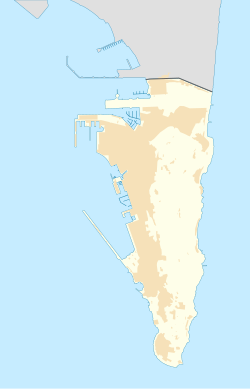| Devil's Gap Battery | |
|---|---|
Punta del Diablo | |
| Part of Fortifications of Gibraltar | |
| Upper Rock Nature Reserve, Gibraltar | |
 View of the BL 6 inch Mk VII naval gun at Devil's Gap Battery. | |
 Devil's Gap Battery (North gun) | |
| Site information | |
| Type | Artillery battery |
| Owner | Government of Gibraltar |
| Controlled by | Gibraltar Heritage Trust |
| Open to the public | Partially |
| Condition | Mostly derelict |
| Location | |
Location of Devil's Gap Battery within Gibraltar | |
| Coordinates | 36°08′13″N5°21′02″W / 36.136878°N 5.350445°W |
| Height | 130 metres (430 ft) above sea level |
Devil's Gap Battery is a coastal battery in the British Overseas Territory of Gibraltar, overlooking the Bay of Gibraltar near the westernmost limits of the Upper Rock Nature Reserve.






